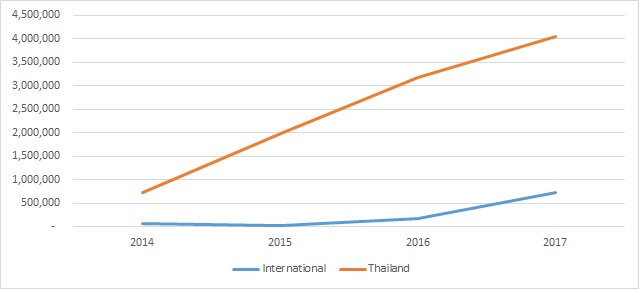Low-cost carrier Thai Lion Air is making a push to bolster its international network, with a strong emphasis on China.
FlightGlobal schedules data shows that the Bangkok Don Mueang-based unit of Indonesia's Lion Air Group has already added six international destinations from its base airport in 2017: Chengdu, Chongqing, Guangzhou, Hanoi, Nanchang, and Nanjing.
For 2017, FlightGlobal schedules indicates that it will offer 735,400 outbound seats on international services, a nearly fourfold increase on the 175,000 outbound international seats it offered in 2016. This means that for every 5.5 domestic seats offered in 2017, it will offer one international seat; in 2016 the ratio was 18.2 to one.
Thai Lion seat capacity on domestic, international routes

FlightGlobal Schedules
Apart from an effort to benefit from booming Chinese tourism, Thai Lion's move is also no doubt related to the competitive situation in Thailand, characterised as it is by yield pressure, slot constraints and over-saturation.
Domestically, Thai Lion operates in the heart of the country's unforgiving market. The carrier's three biggest routes from Bangkok Don Mueang are Hat Yai, Chiang Mai and Phuket.
Thai Lion's 61,000 monthly seats on Bangkok-Hat Yai give it a 34.4% share of the market, but it is by no means dominant: Thai AirAsia has a 28.2% share, Nok 19.7%, and Thai Smile 17.6%.
Bangkok-Chiang Mai is a free-for-all among seven carriers that have roughly equal market shares. Bangkok-Phuket, meanwhile, has eight carriers. Here, Thai Lion's 36,000 seats make it the sixth largest player with 10.1% of capacity in the market.
Thai Lion continues to do its part by the Lion Air Group and take new jets. Flight Fleets Analyzer shows that as of 1 August it operated 27 Boeing 737 aircraft, up five from a year earlier.
Thai Lion's position on its new international routes

FlightGlobal Schedules
The pace of new jet arrivals, all drawn from Lion's order book, has slowed. Flight Fleets Analyzer shows that Thai Lion added nine aircraft in the 12 months to August 2015, and eight in the 12 months to August 2016.
As for Thai Lion's international forays, there is still plenty of competition. In the case of Guangzhou and Hanoi, the large number of rivals makes the market dynamic arguably as bad or worse than those that Thai Lion is accustomed to at home.
It also recently announced two additional international services: a four-times weekly Chiang Rai-Changsha service started on 10 August. It will also begin a Bangkok Don Mueang-Changsha service on 1 September, and a Bangkok Don Mueang-Denpasar service on 15 September.
It will be the only carrier on the Chiang Rai-Changsha route. On flights to Changsha Thai Lion will compete with NewGen Airways, Orient Thai Airlines and Thai AirAsia. On the Bangkok-Denpasar route, it will operate alongside Indonesia AirAsia and Thai AirAsia.
Thai Lion also could be looking farther afield than China and Southeast Asia. A recent Bangkok Post report indicates that it is seeking approval to operate Airbus A330 aircraft, apparently to be obtained from Lion. Flight Fleets Analyzer shows that Lion operates three A330-300s, using them on a combination of charters and scheduled services.
Thai Lion reportedly also plans to launch services to South Korea and Japan – a move dependent on ICAO lifting the safety red flag it has imposed on Thailand since 2015 – and India.
Larger jets and more destinations would better position Thai Lion against Thai AirAsia and its Thai AirAsia X long-haul, low-cost unit. Lion's limitless order book will ensure that Thai Lion has the firepower to do so.
Source: Cirium Dashboard



















